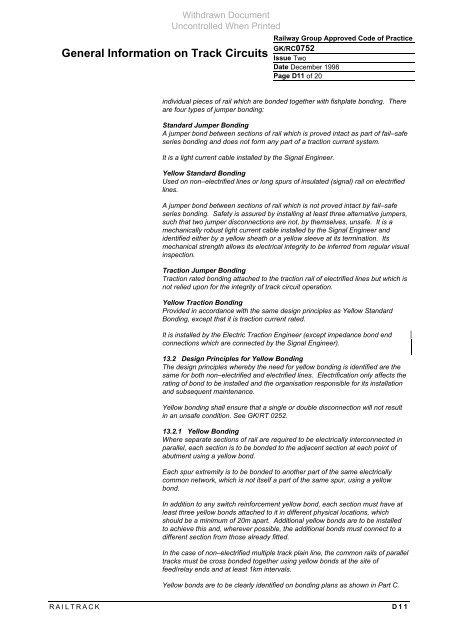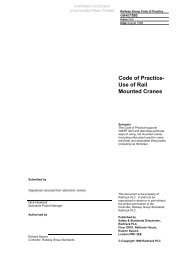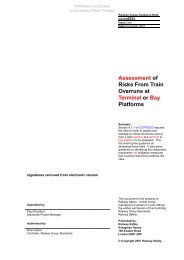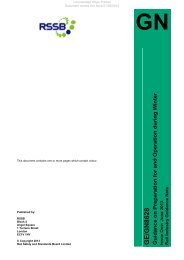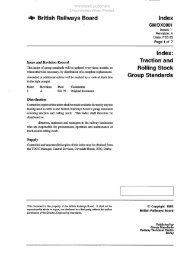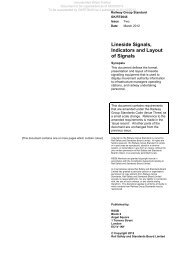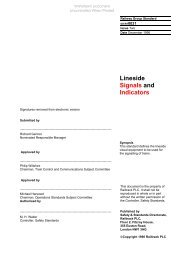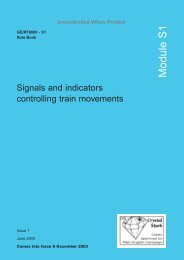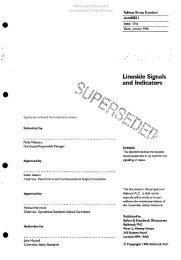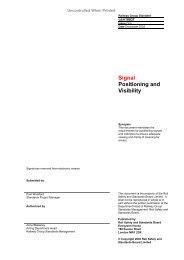General Information on Track Circuits - RGS Online
General Information on Track Circuits - RGS Online
General Information on Track Circuits - RGS Online
You also want an ePaper? Increase the reach of your titles
YUMPU automatically turns print PDFs into web optimized ePapers that Google loves.
Withdrawn Document<br />
Unc<strong>on</strong>trolled When Printed<br />
<str<strong>on</strong>g>General</str<strong>on</strong>g> <str<strong>on</strong>g>Informati<strong>on</strong></str<strong>on</strong>g> <strong>on</strong> <strong>Track</strong> <strong>Circuits</strong><br />
Railway Group Approved Code of Practice<br />
GK/RC0752<br />
Issue Two<br />
Date December 1998<br />
Page D11 of 20<br />
individual pieces of rail which are b<strong>on</strong>ded together with fishplate b<strong>on</strong>ding. There<br />
are four types of jumper b<strong>on</strong>ding:<br />
Standard Jumper B<strong>on</strong>ding<br />
A jumper b<strong>on</strong>d between secti<strong>on</strong>s of rail which is proved intact as part of fail–safe<br />
series b<strong>on</strong>ding and does not form any part of a tracti<strong>on</strong> current system.<br />
It is a light current cable installed by the Signal Engineer.<br />
Yellow Standard B<strong>on</strong>ding<br />
Used <strong>on</strong> n<strong>on</strong>–electrified lines or l<strong>on</strong>g spurs of insulated (signal) rail <strong>on</strong> electrified<br />
lines.<br />
A jumper b<strong>on</strong>d between secti<strong>on</strong>s of rail which is not proved intact by fail–safe<br />
series b<strong>on</strong>ding. Safety is assured by installing at least three alternative jumpers,<br />
such that two jumper disc<strong>on</strong>necti<strong>on</strong>s are not, by themselves, unsafe. It is a<br />
mechanically robust light current cable installed by the Signal Engineer and<br />
identified either by a yellow sheath or a yellow sleeve at its terminati<strong>on</strong>. Its<br />
mechanical strength allows its electrical integrity to be inferred from regular visual<br />
inspecti<strong>on</strong>.<br />
Tracti<strong>on</strong> Jumper B<strong>on</strong>ding<br />
Tracti<strong>on</strong> rated b<strong>on</strong>ding attached to the tracti<strong>on</strong> rail of electrified lines but which is<br />
not relied up<strong>on</strong> for the integrity of track circuit operati<strong>on</strong>.<br />
Yellow Tracti<strong>on</strong> B<strong>on</strong>ding<br />
Provided in accordance with the same design principles as Yellow Standard<br />
B<strong>on</strong>ding, except that it is tracti<strong>on</strong> current rated.<br />
It is installed by the Electric Tracti<strong>on</strong> Engineer (except impedance b<strong>on</strong>d end<br />
c<strong>on</strong>necti<strong>on</strong>s which are c<strong>on</strong>nected by the Signal Engineer).<br />
13.2 Design Principles for Yellow B<strong>on</strong>ding<br />
The design principles whereby the need for yellow b<strong>on</strong>ding is identified are the<br />
same for both n<strong>on</strong>–electrified and electrified lines. Electrificati<strong>on</strong> <strong>on</strong>ly affects the<br />
rating of b<strong>on</strong>d to be installed and the organisati<strong>on</strong> resp<strong>on</strong>sible for its installati<strong>on</strong><br />
and subsequent maintenance.<br />
Yellow b<strong>on</strong>ding shall ensure that a single or double disc<strong>on</strong>necti<strong>on</strong> will not result<br />
in an unsafe c<strong>on</strong>diti<strong>on</strong>. See GK/RT 0252.<br />
13.2.1 Yellow B<strong>on</strong>ding<br />
Where separate secti<strong>on</strong>s of rail are required to be electrically interc<strong>on</strong>nected in<br />
parallel, each secti<strong>on</strong> is to be b<strong>on</strong>ded to the adjacent secti<strong>on</strong> at each point of<br />
abutment using a yellow b<strong>on</strong>d.<br />
Each spur extremity is to be b<strong>on</strong>ded to another part of the same electrically<br />
comm<strong>on</strong> network, which is not itself a part of the same spur, using a yellow<br />
b<strong>on</strong>d.<br />
In additi<strong>on</strong> to any switch reinforcement yellow b<strong>on</strong>d, each secti<strong>on</strong> must have at<br />
least three yellow b<strong>on</strong>ds attached to it in different physical locati<strong>on</strong>s, which<br />
should be a minimum of 20m apart. Additi<strong>on</strong>al yellow b<strong>on</strong>ds are to be installed<br />
to achieve this and, wherever possible, the additi<strong>on</strong>al b<strong>on</strong>ds must c<strong>on</strong>nect to a<br />
different secti<strong>on</strong> from those already fitted.<br />
In the case of n<strong>on</strong>–electrified multiple track plain line, the comm<strong>on</strong> rails of parallel<br />
tracks must be cross b<strong>on</strong>ded together using yellow b<strong>on</strong>ds at the site of<br />
feed/relay ends and at least 1km intervals.<br />
Yellow b<strong>on</strong>ds are to be clearly identified <strong>on</strong> b<strong>on</strong>ding plans as shown in Part C.<br />
RAILTRACK D11


